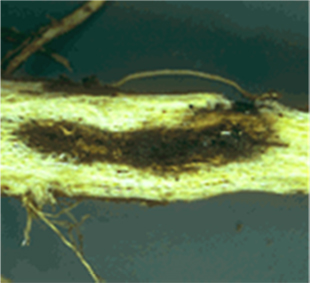G2080
Alfalfa Crown and Root Rots and Stand Longevity
Crown and root rots damage alfalfa stands over time. This publication describes the causes and symptoms of the common diseases, and offers management strategies to reduce their impact.
Stephen N. Wegulo, Extension Plant Pathologist
Bruce E. Anderson, Extension Forage Specialist
- The Role of Crown Injury and Stress in Crown and Root Rot Development
- Causes of Crown and Root Rot
- Symptoms
- Managing Alfalfa to Reduce Crown and Upper Root Rot Development and Increase Stand Longevity
- Managing Alfalfa to Reduce Crown and Root Rot Development and Increase Stand Longevity
- Acknowledgments
Alfalfa (Medicago sativa L.) is the most important forage crop species in North America. It is well-suited to both rain-fed and irrigated production in Nebraska. Under favorable growing conditions and proper management, alfalfa stands in Nebraska can last for at least seven years. However, many factors contribute to the decline in productivity of an alfalfa stand.
Crown and root rots are chronic diseases that occur wherever alfalfa is grown. In stands more than 2 years old, most alfalfa plants show some crown and root rot. Vigorous plants survive by producing new crown buds and lateral roots.
When pressures from disease and stress become too great, infected plants die. The stand is thinned, weeds invade, and both yield and quality are reduced.
Crown and root-rotting organisms are major contributors to the progressive decline of productive alfalfa stands. Managing an alfalfa stand for longevity, therefore, involves practices that prevent or slow down crown and root rot development.
The Role of Crown Injury and Stress in Crown and Root Rot Development
Crown injury and plant stress strongly influence the development and severity of alfalfa crown and root rots. Crown or root injury often provides a point of entry for crown and root-rotting fungi. Crown and root feeding insects, the alfalfa stem nematode, machinery traffic from harvesting and cultivating, and improper fall grazing practices all are associated with crown injury and resulting infections.
Stored carbohydrates (sugars) in taproots are essential for winter survival, regrowth in the spring, and crown and root rot resistance. After alfalfa is cut, carbohydrate reserves are used during new shoot regrowth. Practices that reduce carbohydrate reserves cause stresses that predispose alfalfa plants to infection by crown and root rotting fungi. These practices include cutting at the bud stage or earlier while carbohydrate reserves in the roots are low due to new shoot regrowth, or cutting in late September or early October, thus allowing only a short time for regrowth before the onset of winter dormancy.
Plants going into winter with low carbohydrate levels in the upper taproots may not have sufficient cold tolerance to protect them from winter injury. These weakened plants also are susceptible to infection by crown and root-rotting fungi and to winter injury. When winter injury occurs, the wounded crown tissue soon is invaded by primary and secondary rot organisms.
Causes of Crown and Root Rot
The term crown and root rot complex describes a group of general crown and upper root diseases known as crown rot, collar rot, heart rot and hollow crown. It does not refer to diseases of the lower taproot or feeder roots caused by Phytophthora, Pythium, and several other root-rotting fungi.
Many organisms, including fungi and bacteria, cause decay of crowns and roots of alfalfa. Many of these organisms occur together, causing a disease complex.
Fungi are the primary organisms associated with crown and upper root rot of alfalfa. The most frequently isolated fungi from diseased crowns and roots are species of Fusarium. These fungi live in the soil or in infected crowns and roots of alfalfa plants. Crowns and roots of young plants may be invaded by one or more Fusarium fungi without the plant showing detrimental effects.
|
Secondary crown rotting fungi invade plants soon after the initial invading fungi and contribute to the overall crown and root rot complex. Usually rot develops slowly in crown tissues and in upper taproots over a period of several months or years. Some of the other fungi isolated from diseased crowns and roots include species of Phoma, Colletotrichum, Phytophthora, and Rhizoctonia. The fungus Rhizoctonia solani, which causes Rhizoctonia stem canker in alfalfa when in combination with either Fusarium or Phoma, causes a brown necrosis of crown bud tissue. As infected plants age, more crown buds are invaded each season until most regrowth tissue has been killed. In addition, Rhizoctonia also invades the crown directly, either from stem lesions or from the soil.
Violet root rot, caused by Rhizoctonia crocorum, occasionally occurs in Nebraska in fields with poor drainage. This fungus infects mature plants. Diseased areas form a roughly circular pattern in the field.
The anthracnose fungus, Colletotrichum trifolii, causes a crown rot that leads to a rapid deterioration of alfalfa stands. Infected plants are either killed outright by the fungus or die during winter. Infection by this fungus can also reduce the cold tolerance of the plant.
It is not unusual to find both anthracnose crown rot and Fusarium-caused crown rot in the same plant. Further information can be found in NebGuide G2081, Alfalfa Anthracnose.
Phytophthora root rot caused by Phytophthora megasperma f. sp. medicaginis is most damaging on susceptible cultivars, where the soil remains wet due to high clay content, poor drainage, over-irrigation or a combination of these factors. Phytophthora causes damping-off of seedlings, root rot, and rot of lower stems (Figure 1). Additional information on Phytophthora root rot is available in NebGuide G2078, Phytophthora Root Rot of Alfalfa.
Symptoms
The general symptoms of crown and root rot are deterioration and discoloration of infected tissue. Some crown and root rots have distinctive symptoms and are easily identified. Since most crown and root rots involve more than one type of organism, positive identification of the cause often requires laboratory examination. Even then, if several organisms are present, it may be difficult to identify the primary cause of decline.
Diseased crowns and upper taproots appear shredded, and the color of rotted tissue varies from dark orange to reddish-brown to purple to black (Figure 2).
The outside of infected roots may show limited discoloration, but the core of the taproot and crown tissues will be rotted and appear reddish to dark brown. Crowns and upper taproots infected by Fusarium fungi are reddish to dark brown (Figure 3).
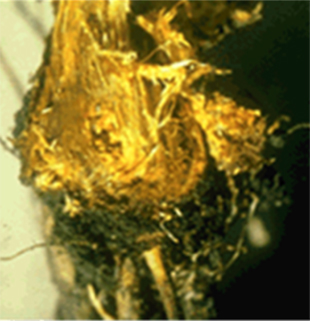 |
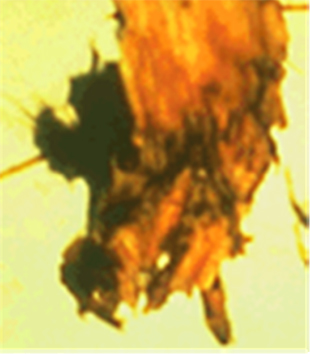 |
|
| Figure 2. Diseased crown and upper taproot. | Figure 3. Reddish brown crown rot caused by Fusarium. |
Rot of the center of the crown that extends into the upper taproot is called heart rot or hollow crown. This type of crown rot develops slowly; diseased tissues first appear moist, then later become dry and remain firm. Plants often can survive for years with moderate injury.
In the later stages the rot may involve both cortex and vascular tissues. If Phoma is present, the rotted area appears as dark brown to black wedge-shaped lesions or as long lesions on crown branches. Crown rot often causes plants to grow unevenly due to death of crown buds on one side of the crown.
Taproots of plants having violet root rot are covered with a dark purplish-brown mat of fungus mycelium (Figure 4). Anthracnose spreads from the base of stems into the crown and upper taproot. It causes a bluish-black crown rot (Figure 5) that may extend from the base of infected stems into the upper taproot. Anthracnose and Fusarium crown rots sometimes are present in the same crown. The bluish-black symptom of anthracnose is distinctive enough to distinguish it from other crown rots.
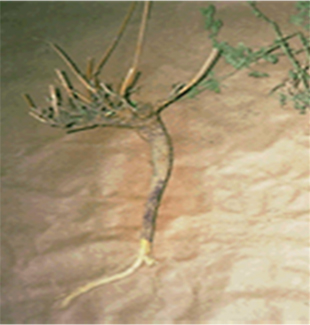 |
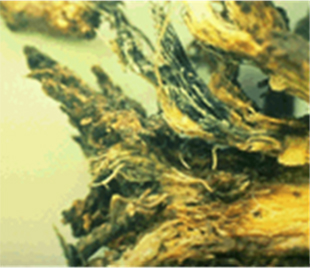 |
|
| Figure 4. The dark purple discoloration of taproot by violet root rot. | Figure 5. Bluish black crown rot caused by anthracnose. |
Managing Alfalfa to Reduce Crown and Upper Root Rot Development and Increase Stand Longevity
Proper management of alfalfa can reduce the development of crown and root rots and cold temperature injury. The development of the crown and root rot complex can be slowed or increased by management practices. High levels of stored carbohydrate reserves in roots will improve the plant’s ability to withstand severe winters and overcome winter injury and crown and root rot.
Managing Alfalfa to Reduce Crown and Root Rot Development and Increase Stand Longevity
- Select winter-hardy alfalfa varieties resistant to bacterial wilt, anthracnose, Phytophthora root rot, stem nematode, and Verticillium wilt.
- Plant in soil suitable for growing alfalfa.
- Fertilize with phosphorus and potash as needed, based on soil tests.
- Adjust soil pH to 6.6 to 7.5 by liming.
- Irrigate stands prior to cutting.
- Allow soils to become firm before driving heavy equipment on them.
- Delay new irrigations until regrowth has begun.
- Do not cultivate stands for weed control or fertilizer incorporation.
- Adjust harvest intervals to plant growth.
- Do not harvest stands after Sept. 15. There should be at least 6 inches of regrowth to allow buildup of carbohydrate reserves before the first killing frost.
- Control alfalfa weevil, aphid, and potato leaf hopper infestations.
- Graze stands only after alfalfa is fully dormant and the ground is dry and remove animals as soon as the aftermath is depleted.
- Avoid growing alfalfa in compacted soils.
Acknowledgments
John E. Watkins and Fred A. Gray co-authored the previous version of this NebGuide.
This publication has been peer reviewed.
Visit the University of Nebraska–Lincoln Extension Publications website for more publications.
Index: Plant Diseases
Field Crops
Issued June 2011
